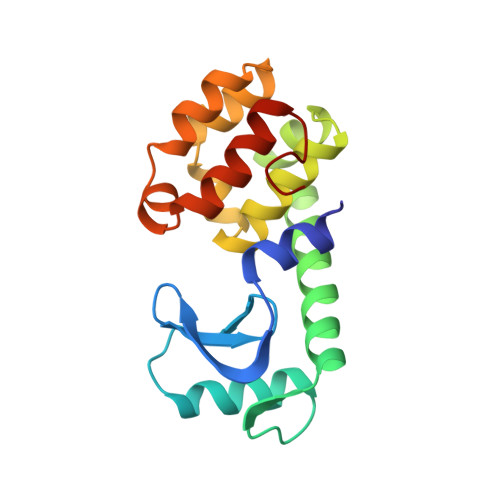Hydrophobic core repacking and aromatic-aromatic interaction in the thermostable mutant of T4 lysozyme Ser 117-->Phe.
Anderson, D.E., Hurley, J.H., Nicholson, H., Baase, W.A., Matthews, B.W.(1993) Protein Sci 2: 1285-1290
- PubMed: 8401213
- DOI: https://doi.org/10.1002/pro.5560020811
- Primary Citation of Related Structures:
1TLA - PubMed Abstract:
The T4 lysozyme mutant Ser 117-->Phe was isolated fortuitously and found to be more thermostable than wild-type by 1.1-1.4 kcal/mol. In the wild-type structure, the side chain of Ser 117 is in a sterically restricted region near the protein surface and forms a short hydrogen bond with Asn 132. The crystal structure of the S117F mutant shows that the introduced Phe side chain rotates by about 150 degrees about the C alpha-C beta bond relative to wild type and is buried in the hydrophobic core of the protein. Burial of Phe 117 is accommodated by rearrangements of the surrounding side chains of Leu 121, Leu 133, and Phe 153 and by main-chain shifts, which result in a minimal increase in packing density. The benzyl rings of Phe 117 and Phe 153 form a near-optimal edge-face interaction in the mutant structure. This aromatic-aromatic interaction, as well as increased hydrophobic stabilization and elimination of a close contact in the wild-type protein, apparently compensate for the loss of a hydrogen bond and the possible cost of structural rearrangements in the mutant. The structure illustrates the ability of a protein to accommodate a surprisingly large structural change in a manner that actually increases thermal stability. The mutant has activity about 10% that of wild-type, supportive of the prior hypothesis (Grütter, M.G. & Matthews, B.W., 1982, J. Mol. Biol. 154, 525-535) that the peptidoglycan substrate of T4 lysozyme makes extended contacts with the C-terminal domain in the vicinity of Ser 117.
Organizational Affiliation:
Institute of Molecular Biology, Howard Hughes Medical Institute, University of Oregon, Eugene 97403.
















